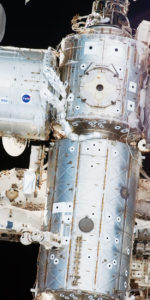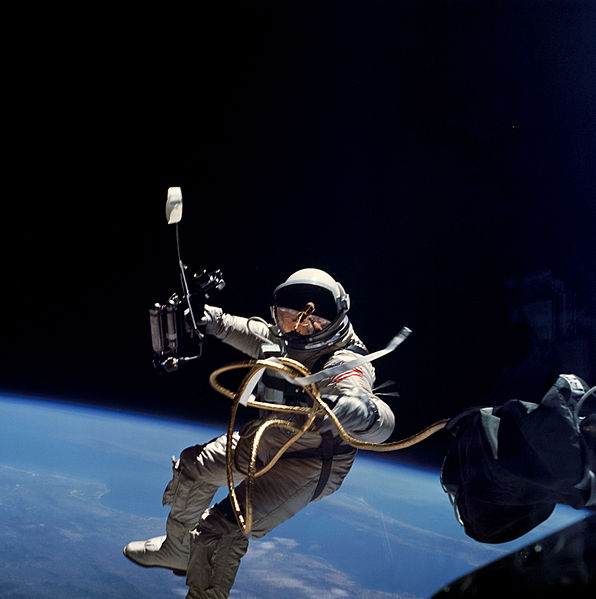
Fifty years ago, today, on 18 March 1965, a 30-year-old Soviet cosmonaut named Alexei Leonov became the first human in history to depart the confines of his spacecraft in a pressurized suit and float freely into the limitless void beyond. As described in two previous AmericaSpace history articles—available here and here—Leonov spent 12 minutes outside the Voskhod 2 spacecraft, tumbling in the void, as part of the latest in a line of Soviet spectaculars, designed to outdo the United States. It had long been apparent that spacewalking, or “Extravehicular Activity” (EVA), was a central tenet of Project Gemini that NASA needed to master, before sending humans to the Moon in fulfilment of President John F. Kennedy’s bold challenge. The first U.S. spacewalk, by astronaut Ed White, occurred a few weeks later, in June 1965, and ushered in a new technology which would see humans explore the surface of the Moon, weld, repair, and upgrade satellites and space telescopes, work in untethered conditions, and build one of the brightest objects in Earth’s skies: the International Space Station (ISS).
Leonov’s iconic spacewalk, ironically, today places him at the very bottom of the list of 211 men and women from Russia, the United States, France, Germany, Japan, Switzerland, Canada, Sweden, China, and Italy who have embarked on EVAs in low-Earth orbit, in cislunar space, and upon the Moon’s surface over the past half-century, most recently by Terry Virts. Floating through an extendable airlock, Leonov emerged from Voskhod 2’s outer hatch on his “back,” which revealed the grandeur of Earth to one of humanity’s sons for the first time. “I felt the power of the human intellect that had placed me there,” Leonov wrote in his memoir, Two Sides of the Moon, co-authored with U.S. astronaut Dave Scott. “I felt like a representative of the human race … I was overwhelmed by these feelings.” A bracketed movie camera returned fuzzy images of the top of Leonov’s helmet, together with his shoulders and arms, and later his entire body, but the triumph of the EVA almost ended badly, when his suit “ballooned” and proved incredibly difficult to force himself back into the airlock.
Although successful, Leonov’s spacewalk was a direct response to the U.S. plan to demonstrate EVA from its own Gemini spacecraft. In July 1964, Jim McDivitt and Ed White had been assigned to Gemini IV, originally for a seven-day mission to evaluate the performance of fuel cells for the first time. Several missions were in the running to undertake America’s first spacewalk—as were several candidates, namely Gemini IV’s White, Gemini V’s Charles “Pete” Conrad, and Gemini VI’s Tom Stafford—but the Soviet triumph pushed much of the planning not to the right, but to the left.
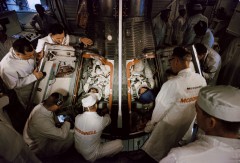
NASA documentation from January 1964 had flagged Gemini IV as the earliest possible flight on which a brief “stand-up” EVA might be attempted, although the availability of equipment presented a major stumbling block and made it more likely that an actual “egress” might not occur until Gemini V or VI. Indeed, in his autobiography, We Have Capture, Stafford wrote that by the time he and fellow astronaut Wally Schirra were formally named to Gemini VI in April 1965, they had known for a year that “we would be flying a very exciting mission” and “I would be taking the first American spacewalk,” but it soon became clear than an EVA would not form part of it. Realigned to occur on Gemini V in August 1965, Alexei Leonov’s EVA prompted NASA management to discuss moving America’s first spacewalk further forward to Gemini IV in June. “It was pretty clear to us that we were in a race,” wrote Deke Slayton in his memoir, Deke. “The Soviet press even said that Leonov’s EVA suit was a prototype for a lunar surface pressure suit.”
In fact, links had been drawn between spacewalking and Gemini IV virtually as soon as McDivitt and White were assigned to the mission and, at the July 1964 press conference, Deputy Program Manager Kenny Kleinknecht announced that one of them might indeed perform a stand-up EVA. The “long pole” remained the availability of equipment, but as the year progressed the AiResearch Manufacturing Company was contracted to build a small chest pack, the David Clark Company received specifications to fabricate the bulky white suit, and McDonnell set to work modifying the Gemini IV spacecraft to support an extravehicular option. The astronauts themselves lobbied strongly for the addition of the G4C extravehicular suit to their mission—equipped with redundant zippers, a pair of outer visors, automatic-locking ventilation settings, and a heavy outer covering—and, in their 1977 history of Project Gemini, Barton Hacker and James Grimwood wrote that McDivitt and White “went far beyond that of the normal test pilot in determining what was to be done and when.”
Altitude chamber tests in November 1964 proved successful, and in the immediate aftermath of Voskhod 2 Bob Gilruth, head of the Manned Spacecraft Center (MSC) in Houston, Texas, and his deputy, George Low, reviewed a hand-held maneuvering unit and lent their support. By mid-May, they had gained the approval of NASA Associate Administrator Bob Seamans, who in turn described the EVA plan for Gemini IV to Administrator Jim Webb and Deputy Administrator Hugh Dryden. One note of concern came from George Mueller, then-head of Manned Space Flight, who doubted that the EVA hardware would be ready for Gemini IV’s targeted launch date. His fears were soon allayed, but Dryden was concerned that the EVA would be perceived as little more than a knee-jerk response to Leonov’s success. At length, he relented and gave offered his approval, scribbled in the corner of Seamans’ report, on 25 May 1965.
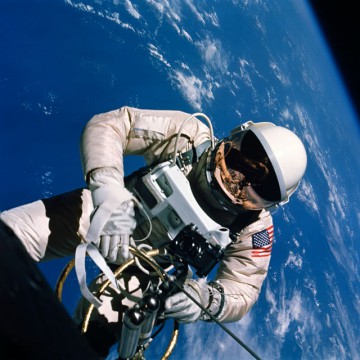
By this stage, Gemini IV’s official press kit had made reference to a “possible extravehicular activity,” which became a certainty just a few days later. Nor would Ed White merely stand on his seat and poke his head through the upper hatch; he would actually leave the spacecraft and maneuver around with the aid of his hand-held device. Following their launch on 3 June, White ventured outside the spacecraft for 21 minutes and “walked” across part of the world, starting over the central Pacific, over California and later Texas, and eventually reaching southern Florida and the island chains of Cuba and Puerto Rico. From inside Gemini IV, McDivitt was concerned that his photography of the event was “not very good,” but in reality his images of America’s first spacewalker proved an iconic record of the early annals of space exploration.
The first few piloted Gemini missions had been assigned very specific tasks—an inaugural shakedown of the vehicle on Gemini 3, the EVA on Gemini IV, long-duration and fuel cells on Gemini V, rendezvous on Gemini VI, and long-duration on Gemini VII—but each of the final six flights of the program were expected to feature a spacewalk of significantly greater complexity than had been performed by White.
First up was Dave Scott on Gemini VIII, who was tasked with spending two hours and 40 minutes outside his spacecraft in March 1966. He would wear an Extravehicular Life Support System (ELSS) on the chest of his suit to feed oxygen from the spacecraft supply and from a backpack, known as the Extravehicular Support Package (ESP), on the rear adapter of Gemini VIII. He would have maneuvered himself to the back of the spacecraft and secured himself into the backpack, a procedure which had required hundreds of hours of training in parabolic aircraft, underwater and on air-bearing tables, before launch. Working outside for 10 times longer than White did, Scott would have to retrieve an experiments package, activate a micrometeoroid detector on Gemini VIII’s Agena-D target vehicle, and test a reactionless power wrench. Unfortunately, a near-catastrophic sequence of problems experienced by Gemini VIII caused its three-day mission to be curtailed after just 10 hours, and Scott never had the opportunity to perform his long-awaited EVA.
By the time Gemini VIII flew, many of the plans for the EVA on Gemini IX had also been thrown into disarray, following the tragic death of its crew, Elliot See and Charlie Bassett, in an aircraft crash. Under the original plans, Bassett would have test-flown the U.S. Air Force’s Astronaut Maneuvering Unit (AMU)—a device which his backup, astronaut Gene Cernan, described in his autobiography, The Last Man on the Moon, as “like a massive suitcase,” which was “so big that it would be carried aloft folded up like a lawn chair and attached within the rear of the Gemini”—through at least one 90-minute orbit of Earth, controlling his motions with hydrogen peroxide thrusters. Throughout the late fall of 1965 and into the spring of 1966, Bassett and Cernan physically conditioned themselves in the gym and at the handball court to prepare for the strength and stamina needed to operate inside their suits.
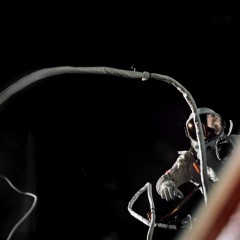
Those suits were extensively modified from the version worn by Ed White, in order to offer additional comfort and protection and to accommodate the demands of EVA. They included a white cotton long-john-type undergarment for the men’s biosensors, a nylon “comfort layer,” a Dacron-Teflon link net to maintain the suit’s shape, and several layers of aluminized Mylar and nylon for thermal and micrometeoroid protection. The death of See and Bassett in February 1966 meant the Gene Cernan and Tom Stafford were promoted from their status on the Gemini IX backup crew to the new prime crew, and they ended up flying the mission in June.
As described in a previous AmericaSpace article, Cernan’s EVA originally encompassed the retrieval of a micrometeoroid package from an Agena-D target vehicle, although this was scratched when the latter experienced a launch failure and ended up at the bottom of the Atlantic Ocean. Years later, Cernan described donning his suit umbilicals inside the cramped Gemini to unleashing a garden hose in a volume no larger than the front seat of a car. Venturing outside, his initial thought was that he was “sitting on God’s front porch,” as orbital darkness gave way to the first rays of a shimmering dawn, and he quickly set to work positioning a camera and retrieving an experiment. However, he very soon came face to face with the harsh reality of spacewalking. Every move affected his entire body, rippling through his umbilical and jostling the spacecraft, in a phenomenon that Cernan likened to wrestling an octopus. One of his recommendations after the flight was for more handrails and an improved propulsion system for controllability.
At length, he moved to the rear of Gemini IX to strap himself into the AMU. However, the stiffness of his suit fought his every move, and as he struggled through his tasks his heart rate peaked at 195 beats per minute and his struggling environmental control system had fogged up his visor. Unable to wipe the stinging sweat from his eyes, Cernan had no choice but to rub his nose on the inside of his visor, just to make a “hole” through which he could see. Working without leverage on the AMU, he found it difficult to turn knobs or extend its armrests, and by this stage Stafford and Mission Control were becoming seriously concerned about his well-being. He was expending energy at a rate equivalent to running up a hundred stairs every minute, and it was Stafford who called an end to the EVA. By the time the beetroot-faced Cernan returned inside Gemini IX, no fewer than 128 minutes had elapsed. He was doused with weightless water droplets from a water pistol, and strips of skin on his swollen hands tore away as he removed his gloves. “When he raised his helmet visor,” wrote Stafford in his autobiography, “I saw that his face was hot pink, like he’d been baked in a sauna too long.”
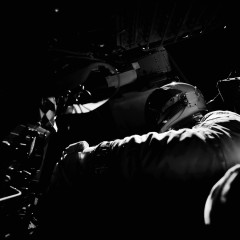
Cernan’s experience demonstrated that EVA was inherently dangerous. Seven weeks later, in July 1966, Gemini X’s Mike Collins became the first human being to record two periods of spacewalking. His first excursion lasted just under an hour and saw him stand on his seat to set up an ultraviolet camera, whilst the second EVA allowed him to actually move outside the spacecraft to retrieve an experiment package from the Agena-D target vehicle. In spite of the greater success of Gemini X, the need to practice spacewalking in a realistic environment had led to the formal adoption of “neutral buoyancy”—submerging fully-suited astronauts in a water tank—as the closest terrestrial analog to the real thing.
In his memoir, Carrying the Fire, Collins related that neutral buoyancy training was introduced shortly before Gemini X, but he had little spare time to practice under such conditions. Gene Cernan, on the other hand, undertook the training and found that it did indeed approximate his efforts in space. Hardware changes were also implemented. “NASA engineers reconfigured future spacecraft and installed a lot of new handholds, railings and stirrups into which future spacewalkers could lock their boots,” related Cernan in The Last Man on the Moon. “These worked so well that we called them the Golden Slippers.”
Yet the difficulties remained. In September 1966, Gemini XI’s Dick Gordon found himself constantly fighting against his suit to keep himself from floating away, which impaired his ability to complete all of his tasks and left him soaked with sweat and with stinging eyes. Thirty-three minutes into the planned 107-minute EVA, he returned inside the cabin, after crewmate Pete Conrad told Mission Control that Gordon had gotten so hot and sweaty that his visibility was drastically reduced. “Those guys were two of the best we had in the program and their problems served to validate mine,” Cernan reflected, “which meant I was no longer the only astronaut who had trouble working in space.”
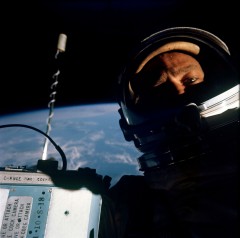
Not until Gemini XII in November 1966 were the fundamentals of basic EVA tasks successfully demonstrated without incident. In light of the difficulties, a final test of the AMU was deleted, in favor of astronaut Buzz Aldrin removing, installing, and tightening bolts with a power tool, operating connectors and hooks, stripping Velcro, and cutting cables. Aldrin spent a considerable amount of time performing neutral buoyancy training, clad in a carefully-ballasted suit to closely approximate the effects of the microgravity environment. Although disparagingly described by Cernan as “working a monkey-board”—a remark with which Aldrin broadly agreed in his memoir, Men from Earth—the work on Gemini XII served to remove another basic doubt in the collective mind of NASA before EVAs could be attempted on the Moon.
Aldrin also became the first person to embark on as many as three discrete sessions of EVA. His first spacewalk saw him install and retrieve experiment packages and his suit did not overheat, thanks to a regimen of two-minute rest breaks, whilst his second saw him connect a tether between Gemini XII and the Agena-D target vehicle for a gravity gradient exercise. “Back in the buoyancy pool, I had torqued bolts and cut metal dozens of times—what I used to call ‘chimpanzee work’—and I had no problem with these chores in space,” he recalled in Men from Earth. “Someone even put a bright yellow paper Chiquita Banana sticker at my busy box.” A final stand-up EVA saw Aldrin dispose of unwanted equipment, wrapping up his third session of extravehicular activity after a total of 5.5 hours.
With Gemini XII, the program ended and the door was ajar for the dawn of Project Apollo, and its goal of planting U.S. boots on the Moon before the end of the decade. That momentous accomplishment would carry the suits and tools and techniques of spacewalking—both figuratively and literally—to their greatest heights and would see astronauts working on an alien surface, and in the equally alien domain of cislunar space, for many hours at a time.
The second part of this article will appear tomorrow.
Want to keep up-to-date with all things space? Be sure to “Like” AmericaSpace on Facebook and follow us on Twitter: @AmericaSpace




